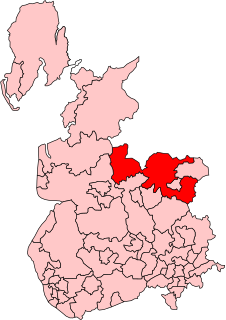
The 1853 New Zealand general election was a nationwide vote to determine the shape of the New Zealand Parliament's 1st term. It was the first national election ever held in New Zealand, although Parliament did not yet have full authority to govern the colony, which was part of the British Empire at that time. Elections for the first provincial councils and their Superintendents were held at the same time.
City of Auckland was a New Zealand electorate formed for the election of 1853. It covered the core of Auckland during the early days of New Zealand democracy, when the city was small enough to be covered by two or three seats. It existed from 1853 to 1860, and from 1890 to 1905.

Clitheroe was a parliamentary constituency in Lancashire.

Nelson is a New Zealand parliamentary electorate, returning one Member of Parliament to the House of Representatives of New Zealand. From 1853 to 1860, the electorate was called Town of Nelson. From 1860 to 1881, it was City of Nelson. The electorate is the only one that has continuously existed since the 1st Parliament in 1853.
The following table indicates the party of elected officials in Massachusetts:
Lyttelton is a former New Zealand parliamentary electorate. It existed from 1853 to 1890, and again from 1893 to 1996, when it was replaced by the Banks Peninsula electorate.
Hutt was a New Zealand parliamentary electorate. It was one of the original electorates in 1853 and existed during two periods until 1978. It was represented by 13 Members of Parliament.
Motueka and Massacre Bay was one of the original parliamentary electorates created for the 1st New Zealand Parliament. It existed from 1853 to 1860 and was represented by three Members of Parliament. In the 1860 electoral redistribution, the area was split in half, and the Motueka and Collingwood electorates were created from it.
Dunedin Country was a parliamentary electorate in the rural area surrounding the city of Dunedin in Otago, New Zealand, from 1853 to 1860. It was a two-member electorate and was represented by a total of five members of parliament.
Pensioner Settlements was a 19th-century parliamentary multi-member electorate in the Auckland region of New Zealand, from 1853 to 1870.
Suburbs of Auckland was a parliamentary electorate in Auckland, New Zealand from 1853 to 1860.
The 1852 and 1853 United States Senate elections were elections which had the Democratic Party gain two seats in the United States Senate, and which coincided with the 1852 presidential election. Only six of the twenty senators up for election were re-elected.
The 1854 and 1855 United States Senate elections were elections which saw the final decline of the Whig Party and the maintained majority of the Democrats. Those Whigs in the South who were opposed to secession ran on the "Opposition Party" ticket, and were elected to a minority. Along with the Whigs, the Senate roster also included Free Soilers, Know Nothings, and a new party: the Republicans. Only five of the twenty-one senators up for election were re-elected.

The 1852 United States elections elected the members of the 33rd United States Congress. The election marked the end of the Second Party System, as the Whig Party ceased to function as a national party following this election. Democrats won the presidency and retained control of both houses of Congress.
This is a list of members of the New South Wales Legislative Council from 1851 to 1856. The 1851 Electoral Act increased the number of members in the Council to 54, 18 to be appointed and 36 elected. The initial appointments were made in October 1851.</ref> The Speaker was Charles Nicholson.

The 1853 New Zealand provincial elections were the first elections in New Zealand to elect members and superintendents to the newly created Provinces of New Zealand. The elections were held between July and September 1853, at the same time as the 1853 New Zealand general elections for the central government, which were held between July and October. The provincial elections had higher voter turnouts than the general elections, with the elections for provincial superintendents having the highest voter turnout.